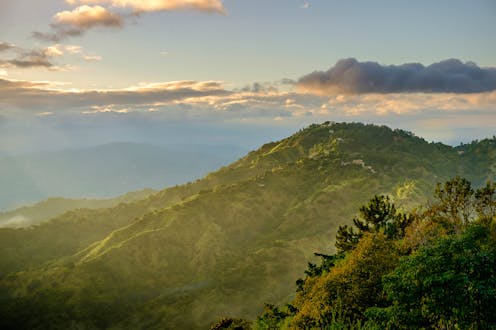
The Blue Mountains of Jamaica are frequently covered in a dense blanket of cloud, but when it lifts the first thing you notice is the cloak of forest extending up their steep slopes to the top of the highest peaks. As you walk up through these trees you encounter an incredible diversity of habitats from the high canopies of the lower slopes to the elfin forests of the ridge tops (barely taller than head height).
Yet new evidence shows that two effects of global climate change are combining to threaten these mountain forests. Climate change increases the intensity of the strongest hurricanes in the region, and it’s also slowly shifting the range of plant and animal species into previously colder zones, towards the north and south poles and up the slopes of mountains to higher altitudes.
Together with an international team of scientists, we have just published new research which shows that, in the Blue Mountains, this species migration was accelerated by Hurricane Gilbert in 1988.
Gilbert caused serious damage to the Blue Mountain forests, snapping the branches and trunks of many of the biggest trees. Most resprouted and survived, but the rate of mortality was particularly high for the species that are restricted to the highest altitude forests. The gaps in the canopy opened up by the death of these trees provided the opportunity for new trees to regenerate, but these tended to be species from lower down the mountain slopes. The net result is that the forest is becoming more dominated by lower altitude species, accelerating a process that was already slowly under way due to global warming.

The Jamaican Blue Mountains rise to an altitude of 2,256 metres so, at present, there is still forested land further up the slopes for the rare mountain species to migrate to. However, once they become confined to the highest mountain ridges there will be nowhere else to go. The impact of an increase in severe hurricanes like Gilbert will bring that threat of extinction ever closer.

This has the potential to be a major contributor to the global biodiversity crisis, showing yet again how it is inextricably linked to the climate crisis. Gilbert was one of the most destructive hurricanes to hit Jamaica in the last century, but there is strong modelling evidence that we will see an increasing number of such intense storms across the Caribbean as a result of climate change.
The Caribbean islands are recognised as one of 36 global biodiversity hotspots and their mountain forests that have avoided deforestation (unlike most of the lowlands) are a particularly important habitat for many endangered species. Lots of the species native to the upper slopes of the Blue Mountains exist nowhere else in the world. Some also exist on a few other Caribbean mountains, but there they will be equally threatened by severe storms.
Australian invaders
All this is made even more serious by yet another combination of damaging human impacts on the natural world: the threat of an increase in intense hurricanes and invasion of forests by species we have introduced from other parts of the world.

The Australian tree Pittosporum undulatum (known locally as “mock orange” because of its brightly coloured fruit) was introduced to a botanic garden in the Blue Mountains more than 130 years ago, yet we now know it has become one of the world’s most invasive species.
In Jamaica, its seeds are dispersed far and wide by native birds and the gaps in the canopy of the natural forests across the Blue Mountains caused by Hurricane Gilbert allowed a huge expansion of its invasion. Pittosporum casts a dense shade and our research has shown that it outcompetes many native trees, particularly threatening the high-altitude species that exist nowhere else and are the most vulnerable to global warming.

Taken together, this evidence is another strong reason to recognise climate change as a threat to global biodiversity. Stopping climate change will clearly be a long and difficult challenge, yet there are some more immediate steps that would reduce the risk of extinction in Caribbean forests. The most important is to much better regulate the movement between countries of species with any potential to become invasive and to control invasive populations where they have already started to threaten biodiverse natural habitats.
Protecting the remaining high-altitude forests from deforestation and degradation will also buy us more time. But unless we can effectively solve this climate-hurricane-invasive species combination of threats, then conservation in these mountains will fail and we will be reduced to trying to preserve species outside their native habitats in botanic gardens or seed banks.
John Healey receives funding from a diversity of research funding organisations. His research in Jamaica was funded by the UK Natural Environment Research Council, Department for International Development Forestry Research Programme and the Royal Society.
Edmund Tanner does not work for, consult, own shares in or receive funding from any company or organisation that would benefit from this article, and has disclosed no relevant affiliations beyond their academic appointment.
This article was originally published on The Conversation. Read the original article.







